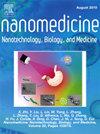靶向纳米体递送TPCA-1调节创伤后骨关节炎小鼠模型的炎症
IF 4.6
2区 医学
Q2 MEDICINE, RESEARCH & EXPERIMENTAL
Nanomedicine : nanotechnology, biology, and medicine
Pub Date : 2025-05-03
DOI:10.1016/j.nano.2025.102827
引用次数: 0
摘要
炎症在膝关节创伤后骨关节炎(PTOA)的发病机制中起着重要作用,其特征是软骨和周围组织受损,导致生理功能丧失。这种炎症主要受NF-κB通路调控。TPCA-1可抑制NF-κB通路中的ikb激酶(IKK) β。在这里,我们通过靶向纳米体优化了TPCA-1向受损膝关节的递送,并研究了其在小鼠PTOA模型中的作用。采用改良的循环机械载荷法诱导小鼠PTOA。小鼠被分为三组,分别接受载TPCA-1溶液、载TPCA-1纳米体。初步研究采用浓度为100 μM的TPCA-1。对照组包括未处理和车辆处理的动物。通过体内显像、血清生化分析、软骨组织基因表达分析、组织病理学和行为分析来评估治疗效果。机械载荷对模型造成明显的膝关节损伤。TPCA-1纳米体明显减轻了负载的不利影响,在减轻炎症方面优于载体和TPCA-1溶液。值得注意的是,tpca -1纳米体组血清总NO和LDH水平显著降低。炎症反应,如MMP13和il - 1β基因表达所示,明显减少。通过IVIS成像、组织学评估和改善的行为指标,证实了软骨保存和功能的增强。通过纳米体靶向递送TPCA-1有效抑制NF-κB通路,导致pta小鼠模型的炎症和软骨损伤显著减少。这一策略显示了潜在的治疗干预,以管理炎症和保持关节健康的骨关节炎。本文章由计算机程序翻译,如有差异,请以英文原文为准。

Targeted nanosome delivery of TPCA-1 for modulating inflammation in a mouse model of post-traumatic osteoarthritis
Inflammation plays a significant role in the pathogenesis of knee post-traumatic osteoarthritis (PTOA) characterized by damage to cartilage and surrounding tissues that results in loss of physiological function. This inflammation is mainly regulated by NF-κB pathway. The TPCA-1 can inhibit IκB kinase (IKK) β in NF-κB pathway. Here, we optimized the delivery of TPCA-1 to the damaged knee joint via targeted nanosomes and examined its effects in a mouse model of PTOA.
PTOA was induced in mice through a modified cyclic mechanical loading method. Mice were divided into groups receiving vehicle, TPCA-1 solution, or TPCA-1-loaded nanosomes. A concentration of 100 μM TPCA-1 was used based on preliminary studies. Control groups included untreated and vehicle-treated animals. Treatment efficacy was assessed using in vivo imaging, serum biochemical assays, gene expression analysis of cartilage tissues, histopathology, and behavioral analysis.
Mechanical loading induced significant knee joint damage in the model. TPCA-1 nanosomes notably attenuated the adverse effects of loading, outperforming both the vehicle and TPCA-1-solution in reducing inflammation. Notably, serum levels of total NO and LDH were significantly lower in the TPCA-1-nanosome group. Inflammation, as indicated by MMP13 and IL1β gene expression, was substantially reduced. Enhanced cartilage preservation and function were confirmed through IVIS imaging, histological assessments, and improved behavior metrics.
The targeted delivery of TPCA-1 via nanosomes effectively inhibits the NF-κB pathway, leading to significant reductions in inflammation and cartilage damage in a PTOA mouse model. This strategy demonstrates potential as a therapeutic intervention for managing inflammation and preserving joint health in osteoarthritis.
求助全文
通过发布文献求助,成功后即可免费获取论文全文。
去求助
来源期刊
CiteScore
11.10
自引率
0.00%
发文量
133
审稿时长
42 days
期刊介绍:
The mission of Nanomedicine: Nanotechnology, Biology, and Medicine (Nanomedicine: NBM) is to promote the emerging interdisciplinary field of nanomedicine.
Nanomedicine: NBM is an international, peer-reviewed journal presenting novel, significant, and interdisciplinary theoretical and experimental results related to nanoscience and nanotechnology in the life and health sciences. Content includes basic, translational, and clinical research addressing diagnosis, treatment, monitoring, prediction, and prevention of diseases.

 求助内容:
求助内容: 应助结果提醒方式:
应助结果提醒方式:


